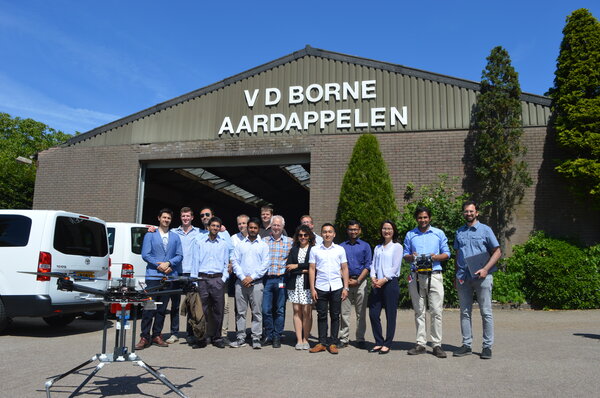Helping mother nature with precision farming

AgriTech is a new, fast growing branch in the Netherlands. To be able to farm at a certain scale, farmers increasingly need information on the exact conditions of their crops. How moist is the soil? Are there pests? And which ones? What plants need (extra) nutrients? In the past ten years, the sector has seen major developments. The enormous amount of data collected in this way not only shows how mother nature works, but also where the farmer can support her.
High tech farming is the future. Research shows that in the next fifty years seventy percent more food is needed to feed the world. Ten percent of this can be achieved by cultivating new land. No less than ninety percent must be obtained from higher yields of existing agricultural land. Farming in the future means looking at each crop separately and assessing what is needed to maximize the yields of the total cropland.
Jacob van den Borne has been working on precision agriculture for years for his potato fields in Reusel: “The use of precision agriculture can save on the use of crop protection agents and fertilizer. The plant gets exactly what it needs. As a result, crop protection agents, fertilizer, labor and soil are used better and more efficiently.”
The province of Noord-Brabant has also recognized the usefulness and necessity of AgriTech. Until 2020, it finances a 4-year program focused on developments in precision farming in which Jacob’s company serves as a practical center. Together they have asked a group of TU/e PDEng trainees to help them make the systems more accurate. JADS (Jheronimus Academy of Data Science in Den Bosch), a joint initiative of the TU/e and Tilburg University, is also involved since the assignment involves collecting, interpreting and acting on large amounts of data.
Farmer Nobi
The group of ten PDEng trainees brought knowledge from two different technical worlds. Six trainees participated from Software Technology and four from Mechatronic Systems Design. To clarify the research question and show the way to possible solutions, they invented an imaginary farmer, named Nobi. “Nobi can view her fields through satellite images and monitor their condition. Possible problems show up, but the possible causes remain unclear. Are the fields infested with vermin? Or is more water needed? To know what exactly is going on, Nobi has to go to the field in person to inspect the situation on the spot. This takes time, and therefore money, and is very inefficient”, the trainees summarize the problem.
The solution they came up with consists of a drone that can fly to a specific location and collect data of the soil or plant. These data can then be reviewed on the farm. This way Nobi can estimate the situation of a detected place from behind the computer and take action on it.
Piercing mechanism
While designing the drone, the trainees faced a number of challenges. Safety was an important issue, as was the way the drone landed, as this might damage the plants. In addition, special ‘legs’ and a piercing mechanism had to be constructed, to enable the drone to position itself exactly on the earthen mounds and collect the necessary data. The weight that the drone could carry was also an issue, because the special landing and piercing system weighted above 4.5 kilograms and the drone had to fly with them.
A number of systems are already available for flying a drone and were used for further software development for autonomous flight. The piercing mechanism required a new invention that had to work in all kinds of soil. In addition, it had to be possible to operate the sensor separately to investigate the moisture of the soil at a certain depth.
Nice result
The trainees enjoyed working on this assignment enormously. For some it was even the first time they saw potato fields! Now they literally stood with their feet in the clay to test and adjust their drone over and over again. The results after eight weeks are amazing, although the trainees are the first to admit that there is still a lot to be done: “The precise positioning has to be improved, and so is the accuracy of the landing. Obstacle detection should also be added. The reliability in unfavorable conditions can also be improved.”
However, considering where the trainees came from, the result are more than satisfying. Jakob de Vlieg of JADS and Jacob van den Borne fully endorse this. “This is really a new step on the road to farming in the future. In addition, this has been a team achievement with good collaboration between different people and organizations. That is what the future needs.”

